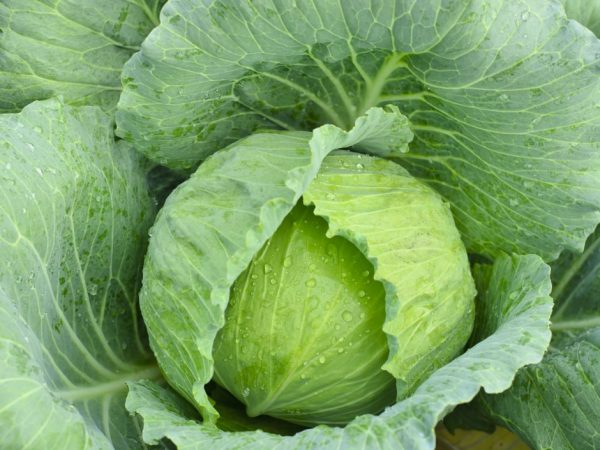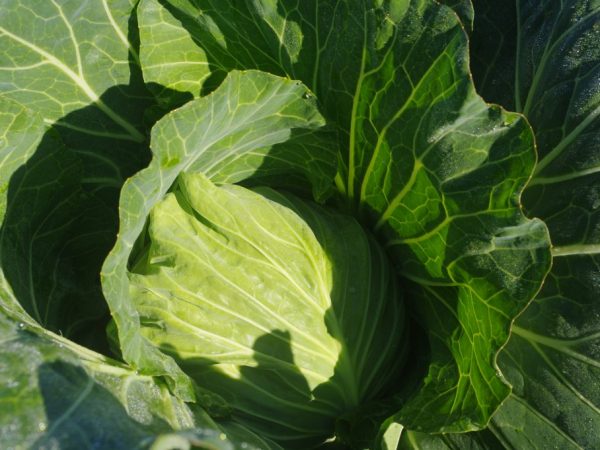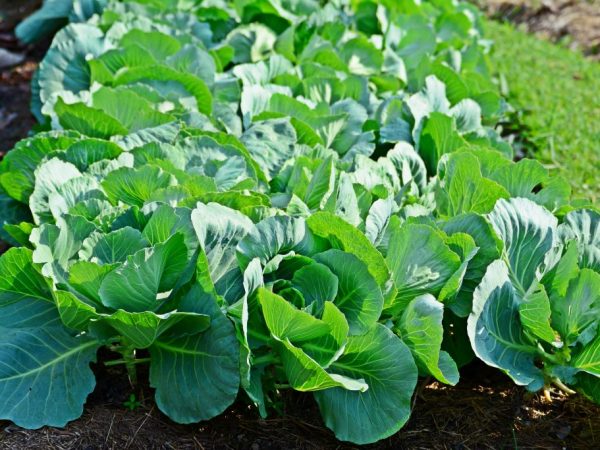Characteristics of cabbage salad Ammon f1
There are many varieties of white cabbage, but Ammon remains one of the most popular late hybrids. Ammon cabbage was bred by Russian breeders specifically for growing in the open field.

Characteristics of cabbage salad Ammon f1
Characteristics of the variety
A feature of Amon cabbage is its high yield (up to 600 centners from 1 sq. / Ha.) Thanks to this, planting a hybrid is possible not only for cultivation on personal plots, but also for commercial production.
Description of the head
The shape of the Ammon f1 cabbage head is round or round-flat, partially covered with an outer leaf.
According to the description, the cultivar has an excellent internal structure with thin leaves and a short compact rosette. Due to the high density of the head, the variety tolerates transportation and long-term storage - up to 11-12 months.
The average weight of one head of cabbage is from 2 to 5 kg. The color is gray-green, has a whitish tint in the section. The taste is delicate, with pleasant freshness, without bitterness. Leaves are medium in size, slightly wavy at the edges, characterized by the presence of a strong waxy bloom.
Due to the large amount of vitamin C in the composition, Ammon cabbage is recommended for people suffering from frequent colds, as well as diseases of the cardiovascular system.
Growing features

The taste of the crop depends on the correct care
When growing Ammon cabbage, planting rules should be observed: the quality of the crop, the amount of nutrients in the vegetable, as well as its taste depend on them.
Soil preparation and planting features
The vegetable feels comfortable in soil with moderate moisture levels and good organic composition.
For a successful planting in the spring, the garden is taken care of since the fall. To do this, before digging for each square meter, add:
- 0.5 kg of lime;
- 0.5 buckets of peat;
- 0.5 buckets of humus.
Ammon cabbage is grown both by seedlings and by sowing in open ground.
Sowing seeds in open ground
Cabbage seeds are sown in spring. A distance of 2-3 cm is maintained between the grains in the hole, at least 9 cm between the rows. After sowing, fresh holes are mulched with a mixture of soil and humus, the area is watered abundantly with water and treated with Semeron herbicide against weeds.
Seedling
Before sowing seedlings, the seeds are soaked in hot water for 20-30 minutes. They are sown, starting in February, to a depth of no more than 1.5 cm. At the same time, the temperature is maintained at least 20 ° C. After germination of the first seeds, the temperature is reduced to 9 ° C.
After 2 weeks, young seedlings dive: they are transplanted into cups or small containers. Seedlings ready for planting in open ground should have at least 6 leaves.
Care
Regular watering
Moderately moist soil has a beneficial effect on the density and juiciness of the heads. It is recommended to water it no more than once every 3 days, avoiding waterlogging.
Hilling
One of the main conditions for good growth of cabbage is timely hilling. This procedure is carried out 2 times:
- 14 days after planting seedlings in the ground;
- one month after the first hilling.
Fertilizer

Cabbage needs feeding
Most often fertilized:
- humus or peat;
- wood ash;
- superphosphates;
- nitrophobic.
Diseases and pests
Cabbage Ammon f1 is characterized by resistance to many diseases, but nevertheless, with improper care or due to heavy rains, the bushes can become infected with infectious diseases:
| Disease | Symptoms | Treatment | Prophylaxis |
| Blackleg | The appearance of black rot on the stem and root stalk. At the same time, the growth and development of the vegetable slows down, and death soon occurs. | The infected areas are removed and the soil is watered with a weak solution of potassium permanganate. | The seeds are treated with granosan (0.2 g of the preparation per 50 g of seeds). |
| Peronosporosis | The defeat of young seedlings with brown spots. The affected sheets are curled. Plant growth slows down. | Processing with a solution of Bordeaux liquid (1%). | Maintenance of an acceptable level of humidity. It is recommended to avoid waterlogging of the soil. |
| Keela | Affects the root system of the plant. It is manifested by the appearance of growths and swellings of various sizes in white. | Removal of affected seedlings by digging together with the ground. | It is recommended to liming the soil before planting seedlings. |
The hybrid variety is immune to most vegetable pests, but changes in weather or disturbances in care can still provoke the appearance of insects.
| Symptoms | Treatment | |
| Aphid | Curling and drying of the leaves of the plant. | Spraying with a solution of soap (household) in a ratio of 20 g of soap to 5 liters of warm water. |
| Cruciferous fleas | The appearance of holes in the leaves, drying of young seedlings. | Processing with a mixture of ash and tobacco in equal proportions. |
| Leaf beetle | Drying of leaves and the appearance of small black bugs. | Treat with actellik (30 g of the drug per 1 sq. M. Area). |
Conclusion
The main advantages of the Ammon f1 variety: high yield and resistance to disease and pests. Also, cabbage is characterized by excellent taste and increased density of the head of cabbage, which allows you to transport the vegetable without fear of damaging it.
Due to the convenience of growing a vegetable crop and the lack of strict maintenance rules, cabbage is popular among gardeners.


